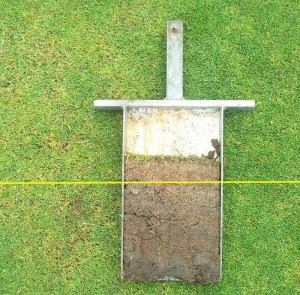
The sward on the majority of UK bowling greens consists of 3 main grass types; various bent grasses (Agrostis), various Fescues (Festuca) and Annual Meadow Grass (Poa annua). Of these, the bent grasses and annual meadow grass are prolific thatch producers.
Thatch consists of dead and dying roots, shoots, leaves, stolons and rhizomes and in comparison to a completely natural setting, it builds up remarkably quickly on fine turf such as bowling greens. This is due to a few factors that are unique to sports surfaces, mainly related to their use and maintenance. Chief among these factors is compaction as we saw yesterday.
Some thatch is good and in fact essential to maintaining the integrity of the surface, but if a layer builds up beyond that (thicker than about 8mm) it can really start to cause big problems.
Flooding, disease, uneven surfaces, Localised Dry Patch, root-break, skinned heads, bare patches, annua meadow grass predominance, weeds, insect damage, thatch fungus, spongy slow surfaces and an endless raft of other problems can ensue if thatch is not kept under control.
On natural grass areas, thatch rarely causes a problem as you can see in this previous article, so the sustainable answer to thatch control is the same as that for a performance green generally; healthy, living soil.
So, if natural grass areas such as meadows and field can look after themselves without us without all of these problems occurring, what can we learn from that?
We need to think about what it is that makes our surface different:
The main negatives that we inflict on our greens:
- Compaction which drastically reduces the aeration pore space in the soil.
- The removal of plant tissue that would normally be recycled by soil microbes (drastically reduced due to compaction) to release nutrients or replaced by animal droppings in a grazing environment.
In-frequent aeration and the application of NPK fertilisers simply isn’t a good enough strategy to re-balance this complex yet very simple equation.
